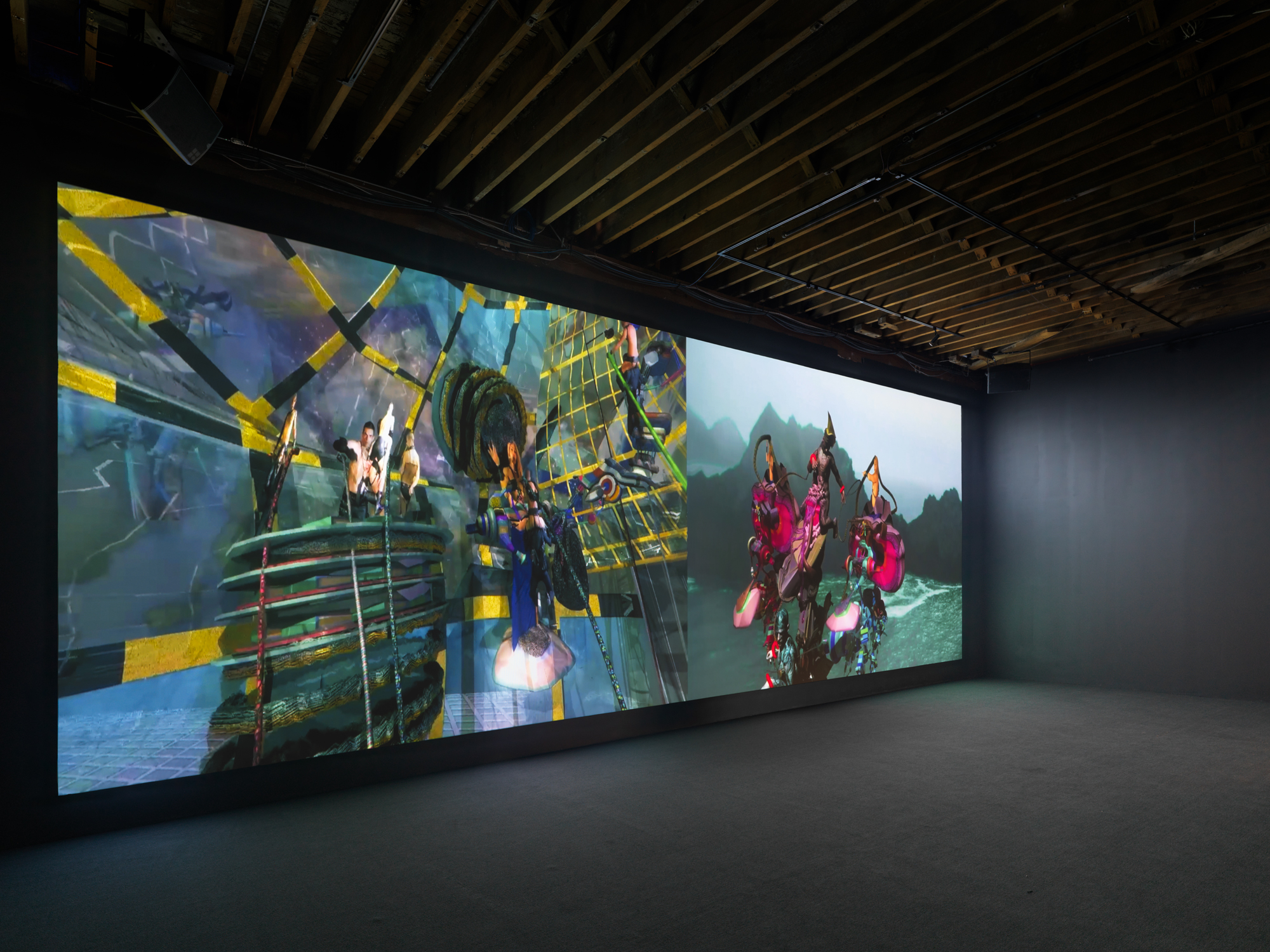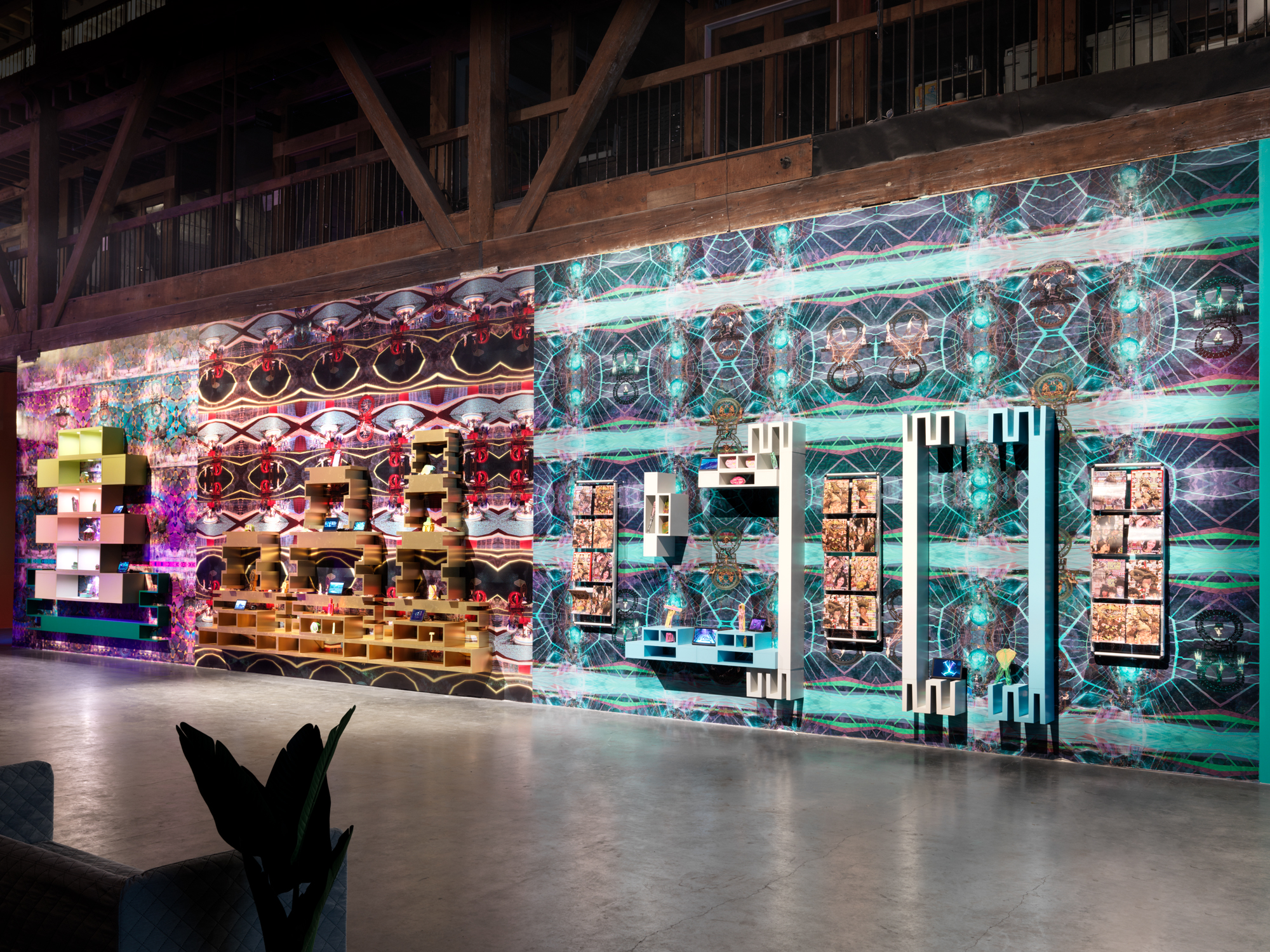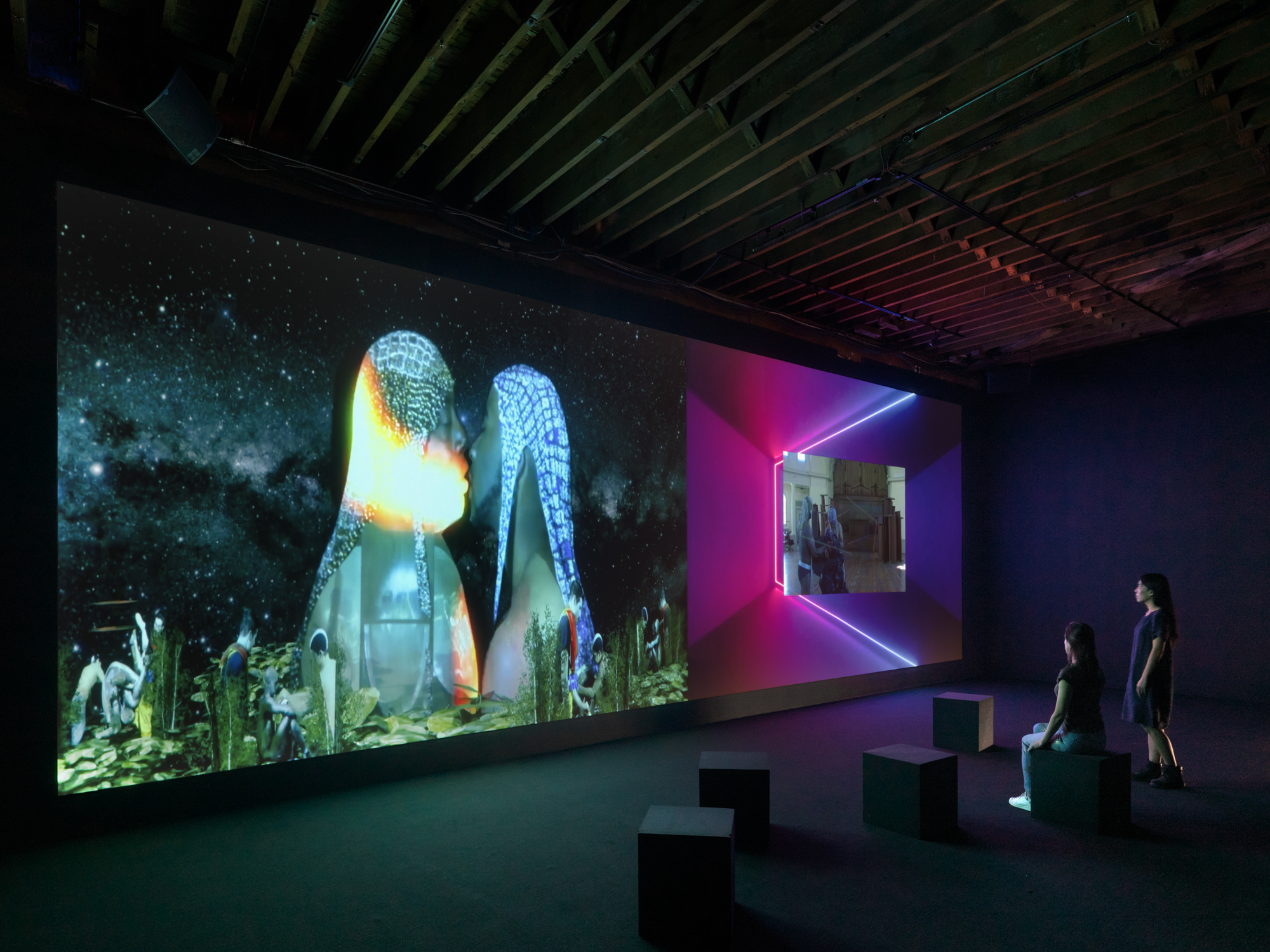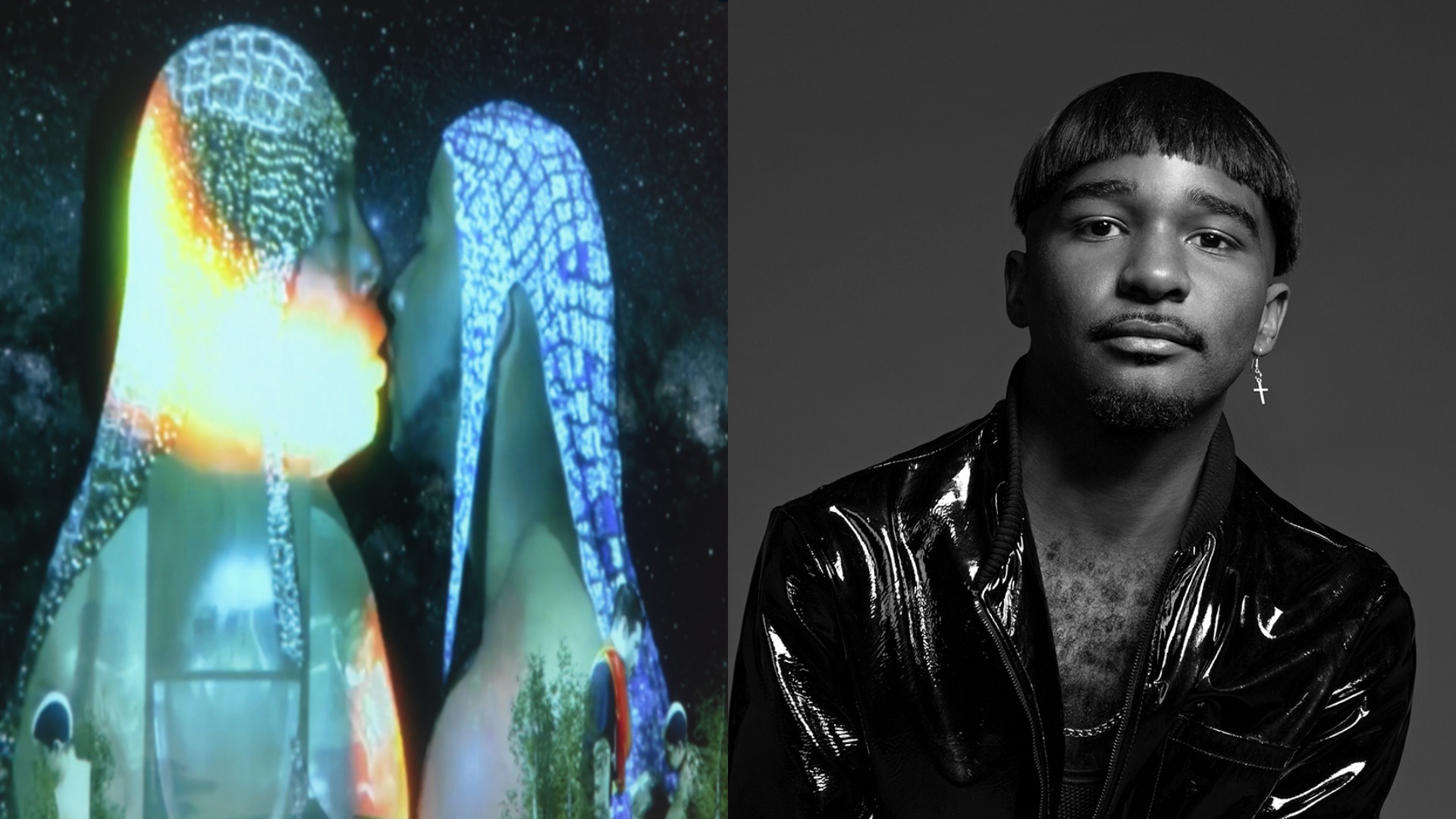Be prepared for sensory overload when you step inside Jacolby Satterwhite’s new show at Brooklyn’s Pioneer Works. Centering around his multi-part, digitally animated series Birds in Paradise, You’re at home is an immersive experience that includes video projections, virtual reality and sculpture. It even includes a retail store that sells records by PAT, his collaborative music project with Nick Weiss (of Teengirl Fantasy) which utilizes recordings by Satterwhite’s mother Patricia.
Built over many years, You’re at home is Satterwhite’s first solo show at a major institution in New York, and it almost feels like a retrospective, as it encompasses so much of his past work, while also setting the stage for what’s to come. Walk through the cavernous space and you’ll see screens featuring naked and leather-clad bodies voguing, gyrating, and miming sexual acts in tangled industrial settings. Fantastical creatures fly through the sky to PAT’s ambient, discordant dance music and Satterwhite’s mother’s innocent, disembodied voice.
“It’s a dystopian reflection, a utopian reflection, a neutral reflection,” says the 33-year-old artist. Satterwhite has become a significant artist over the duration of his short but impactful career, often being grouped under ‘queer art,’ which may be partly why You’re At Home is being hailed as presenting a kind of queer utopia. But Satterwhite says it’s more complicated than that.
“It’s ultimately a reflection of where I am right now. It’s almost like a meditation of me trying to massage out the toxic curiosities and the positive curiosities. It’s just me thriving, living and breathing. It’s some good moments and some bad moments, but it’s just me vulnerably resolving myself in public.”

Incorporating not only his mother’s recordings but also her countless drawings of home goods that she envisioned as her dream product line, You’re at home feels like a reconciliation with the past – both for Satterwhite and his mother, who passed away in 2016 after suffering from schizophrenia.
It’s a theme that’s shared with another monumental project Satterwhite recently worked on – When I Get Home, by Solange (he created a video for the album’s song “Sound of Rain”). Though the similarities in their titles was a coincidence, the sense of personal reckoning was very much intentional.
“I always talked about this period being the end of my Saturn return, and the journey of building this body of work has been very vulnerable. It forced me to reconcile so many things. And so I feel like, at the end of producing this body of work, I got a ton of my agency back. I have a clearer vision and I’m a lot more fearless and liberated.”

Satterwhite is intent on creating new artistic forms, and he achieves this with You’re at home by creating what he calls a “sensational hybridity of concepts.” He is referring to not just his multimedia practices, but also his vulnerable state of “being queer and black in the United States of America,” and his mother’s mental illness. “When you mix the public and the private, it does create quite a vulnerable conflict that probably yields the most interesting things an artist can do,” he says. “I’m just pulling from a constant vulnerability and fear and uncertainty in order to generate new forms.”
Satterwhite himself appears countless times throughout You’re at home, dancing among the “50 or 60” other performers he solicited. Utilizing his own naked body repeatedly in the work wasn’t just a way to etch the personal into the political; it was also convenient. “I don’t want to waste anyone else’s time asking them to do banal, irregular movements for eight hours a day and do outfit changes on the green screen,” he says of the laborious process. “It [my body] was a resource that I had that I could master and have fun with for myself.”

He likens this process to pioneering artist Bruce Nauman, who also “used his body as a framework.” Satterwhite says, “Since I’m more of a postmodernist human being in the Instagram era, where data mining is the new oil currency, I believe that certain kinds of symbolic things that are my identity are things that I should use serially in the work, to make something that is much more compelling than what we should get out of data mining,” he laughs. “I have access to my body all day, so it’s a medium, it’s a conduit for the message, you know? It’s not necessarily personal.”
The difference for Satterwhite, however, is that his very existence as a gay black man is politicized. “By nature, my body is going to yield the politic, and that’s why I had to take a long break from painting… So, knowing that my body is a political agent, using it is a natural expression. That’s why in some parts of the film I have myself lynched and shrouded. I’m doing a Nigerian Yorùbá Gẹlẹdẹ masquerade ritual, but when viewers look at it, their take is [informed by] United States history and they think I’m performing some kind of Jim Crow thing, some kind of tragedy. But really I’m re-performing a ritual of renewal. I like to conflate how much my body has problematic agencies that can really deform what you see based on how I neutralize what the gesture is.”
Another question the work raises is of the commodification and consumption of queer culture, as there is so much queer iconography situated around a retail environment. He says, “The burden of capitalism is the underlying subtext of the whole project, considering that it drove my mother crazy – drawing inventions as an outlet for the fantasy capitalist empire that she wanted to live in. She was taught that that desire was a spectrum for happiness, while watching the media for her whole life, and teaching her children that.”

Satterwhite says the “thousands” of drawings of home goods that his mother left behind naturally lent themselves to the retail store he created for the exhibition. For her, these home goods were a source of happiness, while Satterwhite says he found joy in “watching black female pop stars” as he grew up in South Carolina.
“I think that gay men identify with those forces as an escape. Like, when you see someone trying to be larger than life, who represents an adversary you can identify with, they usually become something that you look at over and over again, while you’re trying to escape places that aren’t necessarily safe spaces for you to build, thrive and grow. So maybe, considering my mother’s obsession with pop songs, it felt like a natural progression,” he says, of turning himself into a quasi pop star figure with PAT.
In this way, You’re At Home isn’t just the bona fide realization of Satterwhite’s multifaceted vision, but his mother’s, too. “It’s a collaboration,” he says, simultaneously signaling the end of a period of grief and the beginning of a period of renewal.
—
You’re At Home is on view at Pioneer Works now through November 24. Satterwhite also has a show at the Fabric Workshop and Museum in Philadelphia, called Room for Living, on view through January 19, 2020.
